How EU Businesses Can Access the €21 Trillion RCEP Free Trade Market via Existing Agreements
The European Union is not a signatory to the RCEP agreement, but there are indirect ways in which EU businesses can access this market. We look at the possibilities.
China has ratified the much-anticipated Regional Comprehensive Economic Partnership (RCEP) free trade agreement and said that it hopes other members will ratify the deal for it to take effect from January 1, 2022. That is just five months from now.
The RCEP free trade agreement includes China, Japan, South Korea, the ASEAN nations of Brunei, Cambodia, Indonesia, Laos, Malaysia, Myanmar, Philippines, Singapore, Thailand, and Vietnam together with Australia and New Zealand.
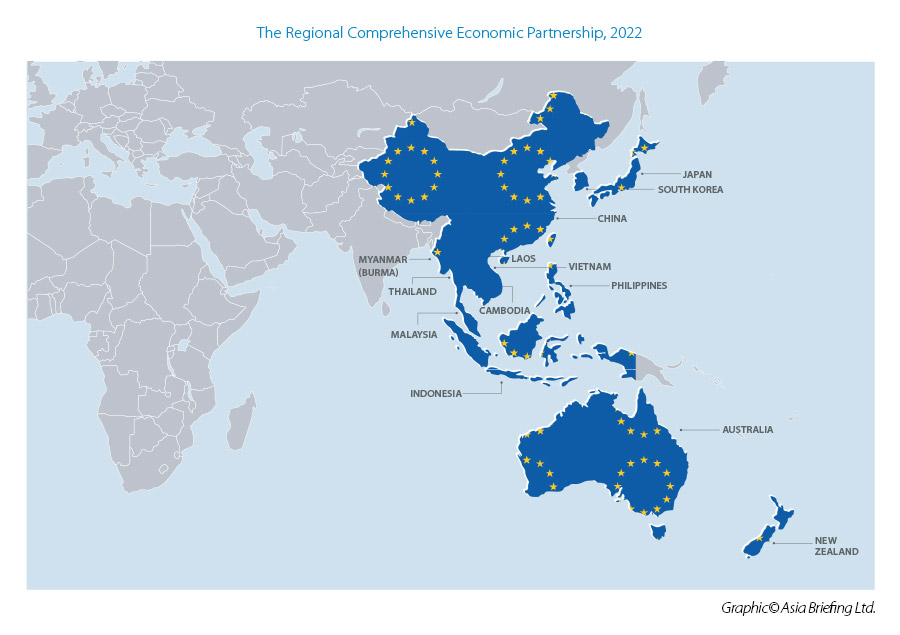
For EU businesses and investors, the RCEP’s sheer size makes it significant. Participating economies account for 29 percent of global GDP and about 30 percent of the world’s population. This equates to a market value of close to € 21 trillion and a total consumer base of about 2.5 billion, of whom an estimated 1 billion are to middle class consumer standards.
The primary aim of the RCEP is to establish a comprehensive economic partnership – building on existing bilateral ASEAN agreements within the region with its FTA partners. It will be guided by a common set of rules and standards, including lowered trade barriers, streamlined processes, and improved market access. For investors, RCEP delivers substantial new trade and investment opportunities within the participating countries and forms Asia’s largest trade bloc to date.
What’s in the Regional Comprehensive Economic Partnership?
The RCEP agreement includes 20 chapters covering many of the articles typically found in a free trade agreement. Notably, it makes significant strides by harmonizing the rules of origin and strengthening IP measures. We can examine some of the primary issues as follows:
Common Rules of Origin
One of the most significant aspects under RCEP is that the rules of origin will be unified for the entire bloc. This will mean that investors will only require one certificate of origin for trading in the region and can bypass the tedious processes of checking and adjusting to the specific rule of origin criteria in each country. When implemented, investors can expect lower costs, added flexibility, and regional supply chains streamlined.
Trade in goods – reduced tariffs
Under RCEP, tariffs will be eliminated on around 92% of goods implemented progressively over the next 20 years, in accordance with each party’s Schedule of Tariff Commitments. This will allow participating countries to gain preferential market access with each other. However, some agricultural and sensitive goods will be excluded from these tariff reductions.
Trade in goods – simplified customs procedures
Simplified customs procedures and enhanced trade facilitation provisions will allow efficient administration of procedures and expeditious clearance of goods, including the release of express consignments and perishable goods within six hours of arrival.
Trade in services
Under RCEP, at least 65% of the services sectors will be fully open to foreign investors, with commitments to raise the ceiling for foreign shareholding limits in various industries, such as professional services, telecommunications, financial services, computer services, and distribution and logistics services.
Not unlike the negative list system in China, RCEP will also take on a ‘negative-list’ approach where the market will be fully open to foreign service suppliers, unless it appears on the list. This ensures transparency of regulations and measures which will allow greater certainty for businesses.
Investment
RCEP eases the process required of investors entering, expanding, or operating in RCEP countries. It also prevents the adoption of further restrictive measures and includes a built-in investor-state dispute settlement mechanism that can be evoked by the member states.
Intellectual protection
RCEP raises the standards of IP protection and enforcement in all participating countries. Aside from securing the protection rights for copyright, and trademark in the normal sense, it also goes further to protect non-traditional trademarks (sound marks, wider range of industrial designs) and forms of digital copyright, which goes beyond what was included in the CPTPP.
E-commerce
The agreement covers areas, such as online consumer protection, online personal information protection, transparency, paperless trading, and acceptance of electronic signatures. It also includes commitments on cross border data flows. This provides a more conducive digital trade environment for businesses and provides for greater access to RCEP markets.
Government procurement
Participating RCEP countries have committed to publish laws, regulations, and procedures regarding government procurement, as well as tender opportunities if available. This allows greater transparency for businesses to pursue government procurement market opportunities in the region. RCEP have also committed to a review aimed at improving this in future.
Although the EU is not a signatory to the RCEP agreement, there are indirect ways in which EU businesses can access this market, including China, through the back door. This is because the EU has signed Free Trade Agreements with four of the member states of RCEP: Japan, Singapore South Korea, and Vietnam. We can examine these as follows:
The EU-Japan Economic Partnership Agreement
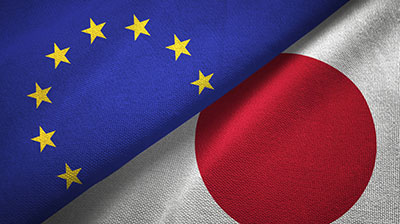
The EU and Japan’s Economic Partnership Agreement entered into force on 1 February 2019. EU firms export nearly €70 billion in goods and €28 billion in services to Japan every year. The trade agreement with Japan removes tariffs and other trade barriers and creates a platform to cooperate to prevent obstacles to trade.
The Economic Partnership Agreement also and scrapped customs duties on 97% of goods imported from the EU. The agreement removed several long-standing non-tariff barriers, for example by endorsing international standards on cars. It broke down barriers for key EU food and drink exporters to Japan’s 127 million consumers and increased export opportunities in a range of other sectors. Annual trade between the EU and Japan should increase by nearly €36 billion once the agreement is fully implemented and given time to make an impact.
Key parts of the Economic Partnership Agreement
With regards to agricultural exports from the EU, the agreement has:
- Scrapped Japanese duties on many cheeses as well as on wine exports (currently at 15% on average);
- Allowed the EU to increase its beef exports to Japan. For pork there is duty-free trade in processed meat and almost duty-free trade for fresh meat; and
- Ensures Japanese protection of more than 200 high-quality European agricultural products, so called Geographical Indications (GIs), and the protection of a selection of Japanese GIs in the EU.
The agreement also secured the opening of services markets, in particular financial services, e-commerce, telecommunications, and transport. It furthermore:
- Facilitates to EU companies access to the procurement markets of 54 large Japanese cities, and removes obstacles to procurement in the economically important railway sector at national level; and
- Addresses specific sensitivities in the EU, for instance in the automotive sector, with transition periods of up to 7 years before customs duties are eliminated.
The agreement also includes a comprehensive chapter on trade and sustainable development; includes specific elements to simplify for small and medium-sized businesses; sets very high standards of labour, safety, environmental and consumer protection; strengthens EU and Japan’s commitments on sustainable development and climate change and fully safeguards public services.
Concerning data protection, the EU and Japan adopted decisions in 2019 to allow personal data to flow freely and safely between the two partners. They agreed to recognise each other’s data protection systems as ‘equivalent’, which will create the world’s largest area of safe data flows.
A large part of another agreement – the Strategic Partnership Agreement between the European Union and Japan – also applies on a provisional basis. This Agreement, together with the Economic Partnership Agreement, was the first bilateral framework agreement between the EU and Japan and strengthened the overall partnership by providing a framework for enhanced political and sectoral cooperation and joint actions on issues of common interest, including on regional and global challenges.
Japan is a mature market, however there may be opportunities to use the EPA to access RCEP and the emerging markets within RCEP – specifically Cambodia and Laos – to perform certain finishing functions under the RCEP agreement. That would reduce overall production costs and assist with EU global competitive pricing and margins.
Dezan Shira & Associates has a partner firm in Tokyo. For assistance with EU investments into the country, and advise about using a Japanese presence to access RCEP please email us at asia@dezshira.com
The EU-Singapore Free Trade Agreement
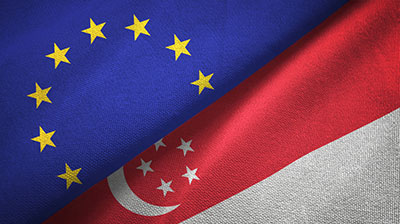
On October 19, 2018, the European Union and Singapore signed the EU-Singapore Free Trade Agreement (EUSFTA) – to deepen the economic relations between the two regions. Along with this deal, two other agreements have been signed between the two sides – the EU-Singapore Investment Protection Agreement (EUSIPA) and the EU-Singapore Partnership and Cooperation Agreement (ESPCA). These trade pacts signal both sides’ strong commitment to free trade at a time of increasing protectionism and is also seen as a prelude to a future FTA between the EU and the Association of Southeast Asian Nations (ASEAN).
Trade links between Singapore and the EU
Singapore is the 17th largest trading partner of the EU for goods and the fourth largest for services. For Singapore, the EU is the country’s second largest trading partner for goods and the largest for services. More than 10,000 EU-based companies use Singapore as a hub for Southeast Asia.
The EU exported over €24 billion worth of goods to Singapore and imported around €17 billion worth of goods in 2020. As regards services, the EU exported as much as it imported from Singapore, around €18 billion in 2020.
At the same time, foreign direct investment (FDI) plays a major role in the economic relations between Singapore and the EU. EU organizations have invested more than €167 billion in the Singaporean economy while at the same time receiving more than €87 billion in inward FDI. The trade volume between the two regions and the amount of mutual FDI makes Singapore a key player for EU trade activity in Asia.
Opportunities arising from EUSFTA
The EUSFTA opens both economies and contains some special provisions regarding trade in goods and services, and a focus on government procurement and geographical indications.
Trade in goods
The EU agreed to reduce its own tariffs to 0 within 5 years after the entry of force of the EUSFTA – cutting 75% of the tariff lines to 0% and the remaining tariff lines within five years. Some existing tariffs, especially on agricultural products, will remain. On the Singaporean side, more than 99% of all goods from the EU are already allowed duty-free access.
The agreement further aims at strengthening cooperation regarding regulatory standards as well as reducing unnecessary technical barriers to trade. Specific rules regarding food safety are also contained. EU standards for automobiles and automotive parts are accepted by Singapore. Electronics third-party testing will be replaced gradually in Singapore to comply with the EU rules. The EU further calls for greater transparency regarding pharmaceutical pricing. Furthermore, green technology must be treated the same as national products in both regions under the agreement.
Trade in services
Trade in services between the EU and Singapore is organized with a positive list. Everything on this list contains sectors that are opened for competition from the partner countries. 12 sectors with more than 160 sub-sectors are included in this list. Amongst others, these are financial services, professional services, computer and related services, research and development, business services, telecommunication services, environmental services, and tourism and travel related services.
Postal services also opened on both sides, which is a sector mostly protected by states. Regarding e-commerce, the parties agreed on greater cooperation as well as to avoid imposing unnecessary restrictions and regulations. Free flow of information will be upheld under international standards of data protection.
Government procurement
Both parties are signatories of the Agreement on Government Procurement (GPA) of the WTO. This opens government procurement for goods and services under competitive bidding for certain sectors. In the EUSFTA, the EU extends this list to EU central government entities, city, and municipal level procurement, public works concessions such as railways, and some additional utilities. The EU dropped the threshold levels for bidding Singaporean companies.
Geographical indications
Geographical Indications (GIs) were one of the main negotiating planks of the EU-Singapore FTA. These are products only produced in a specific region that is protected as kind of trademark under GI. While the EU is the largest provider of these products, Singapore was not very welcoming of the idea. The EU list contains 196 GIs. Singapore ultimately added a list of 196 products to be granted GI status.
Investment protection agreement
The EUSIPA replaced 12 existing Bilateral Investment Agreements between Singapore and the EU member states. The agreement sets standards of fair and equitable treatment (FET) for investments amongst the signatories.
Protection against unreasonable expropriation is contained as well as the right to regulate of the states which says that states remain sovereign in their regulations and there is no possibility of investment arbitration regarding decisions on sovereign debt restructuring. If investment disputes arise, the concerned party must refer the case to a tribunal, to be established under EUSFTA and which will deliver a decision in a pre-defined process. A major aim of the agreement is transparency during the disputes between investors and states.
The financial services sector benefits particularly in greater collaboration on cross-border know-your-customer (KYC) processes, skills development, cybersecurity, and green finance.
Singapore is especially useful as a regional hub as it possesses intra-RCEP banking facilities and other financial and logistics services that are not so easily accessible from the US. Singapore is developing as a massive global e-commerce hub for these reasons. Establishing an EU E-commerce business in Singapore would provide access to the RCEP agreement that Singapore has signed. Companies established in Singapore may be 100% foreign (i.e: European) owned.
Singapore enjoys a corporate income tax rate of 17 percent, with no taxes due on profits realized externally from Singapore. Singapore follows a progressive resident tax rate starting at 0 percent and ending at 22 percent above US$320,000 (£170,000). There is no capital gain or inheritance tax. Income earned by individuals while working overseas is not subject to taxation barring a few exceptions.
Dezan Shira & Associates have an office in Singapore and many of the RCEP member countries and can assist with planning a market entry access strategy. Please contact us at singapore@dezshira.com. Our Doing Business in Singapore guide can be downloaded for free here.
The EU-South Korea Free Trade Agreement
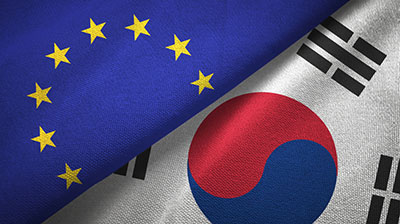
The EU-South Korea FTA was formally ratified in December 2015 and was the EU’s first trade deal with an Asian country.
The EU-South Korea trade agreement eliminated customs duties on 98.7% of all products, including fisheries and agricultural products. It has also removed non-tariff barriers (NTB) to the exports of key EU products to South Korea, such as automobiles, pharmaceuticals, electronics, and chemicals. Services markets in both the EU and South Korea have largely opened to businesses and investors from each other.
Key points of the agreement
- Removes tariffs and other trade barriers and makes it easier for companies on both sides to export and import
- Simplifies paperwork and streamlines technical regulations, customs procedures, rules of origin and product testing requirements
- Boosts trade services in key sectors such as telecommunications, environmental services, shipping, and financial and legal services
- Improves the protection of intellectual property rights in South Korea and recognises a large variety of geographical indications for high-quality European food products on the Korean market
- Allows EU businesses to bid for public procurement tenders in South Korea
- Offers better protection for EU bilateral investments
Benefits for EU exporters
- Machinery and appliances enjoy the largest duty savings, with gains close to €450 million
- The chemical sector is the second-largest beneficiary, with duty savings of €175 million
- Nearly all EU agricultural exports, such as pork, and wines and spirits enjoy duty-free access to the South Korean market, and there are valuable duty-free quotas for products like cheese
- In other industrial sectors
- 93% of customs duties on textiles exports have disappeared
- for glass 85% of customs duties have been eliminated
- for leather and fur 84%
- footwear 95%
- iron and steel 93%
- optical instruments 91%
South Korea is a mature market, however there may be opportunities to use the FTA to access RCEP and the emerging markets within RCEP – specifically Cambodia and Laos – to perform certain finishing functions under the RCEP agreement. That would reduce overall production costs and assist with global competitive pricing and margins.
Dezan Shira & Associates has a Partner firm in Seoul. For enquiries about EU investments into South Korea and how to access the RCEP agreement through investments into the country, please email us at asia@dezshira.com
The EU-Vietnam Free Trade Agreement
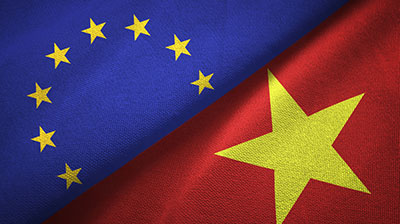
Vietnam’s National Assembly ratified the EU-Vietnam Free Trade Agreement (EVFTA) and the EU-Vietnam Investment Protection Agreement (EVIPA) in August 2020 following almost 10 years of negotiations.
The trade deal gives a much-needed boost to Vietnam’s industries, such as manufacturing, as the country recovers from the COVID-19 pandemic.
65% of duties on EU exports to Vietnam have been immediately eliminated while the remaining will be gradually phased out over a period of 10 years. 71% of duties have been eliminated on Vietnam exports to the EU, with the remaining being eliminated over a period of seven years.
The EVFTA is considered a new generation bilateral agreement – it contains important provisions for intellectual property (IP) rights, investment liberalization, and sustainable development. This includes a commitment to implement the International Labor Organization (ILO) standards and the UN Convention on Climate Change.
Vietnam and the EU are long-standing trading partners. At the end of 2020, EU investors had invested more than €20 billion in 2,133 projects in Vietnam. EU investors are active in 18 economic sectors and in 52 out of the 63 provinces in Vietnam. Investment has been the most prominent in manufacturing, electricity and real estate.
The bulk of the EU investment has been concentrated in areas with good infrastructure, such as Hanoi, Quang Ninh, Ho Chi Minh City, Ba Ria-Vung Tau, and Dong Nai. 24 EU member states are invested in Vietnam, with the Netherlands taking the top spot followed by France.
At the regional level, Vietnam is now the EU’s second most important trading partner among all ASEAN members – surpassing regional rivals Indonesia and Thailand, in recent years. The growing trade between the EU and Vietnam also helps to solidify ASEAN’s position as the EU’s third-largest trading partner.
Industries primed for continued expansion
The EVFTA, at its core, aims to liberalize both tariff and non-tariff barriers for key imports on both sides. For Vietnam, the tariff elimination will benefit key export industries, including the manufacturing of smartphones and electronic products, textiles, footwear, and agricultural products, such as coffee. These industries are also very labor-intensive. Increasing Vietnam’s export volume to the EU, the FTA will facilitate the expansion of these industries, both in terms of capital and increasing employment.
Textiles
Both Vietnam and the EU have articulated a timeframe by which they have committed to liberalizing all tariffs. Key among these commitments is a seven-year timeline for Vietnam’s textile and footwear products. Exports of the sector reached around €7.5 billion in 2020. As a large proportion of Vietnam’s exports to the EU are consumer goods such as clothing, textile, and footwear, the FTA should significantly increase their trade volume.
Electronics
As Vietnam continues to grow, it will shift its manufacturing sector towards more technologically advanced products, such as smartphones and other electronics. The EVFTA will provide more export revenue from clothing and footwear products, but this may not impact the expansion of these industries.
Although Vietnam is yet to have an extensive developed electronic manufacturing industry at present, the FTA provides Vietnam with an unprecedented chance to take a lead in electronic products, and hence expansion of this budding industry could be a smart move for local businesses.
Pharmaceuticals
Vietnam’s pharmaceutical market remains attractive to EU investors. With the FTA in effect, approximately half of EU pharmaceutical imports are now duty-free with the rest exempted from duty by 2028. Foreign pharmaceutical companies are now allowed to establish a company to import pharmaceuticals that have been authorized to be sold in the Vietnamese market. Such entities can sell pharmaceuticals imported by them to Vietnamese distributors or wholesalers. The entities can also build their own warehouses.
While Vietnam’s pharmaceutical market has significantly developed, it still only meets 52% of market demand contributed mostly by generic drugs. The new FTA will bring fair and equal access to the market enabling EU investors to further expand their business and thus allowing foreign investors to meet the strong growth of the pharmaceutical sector
Key highlights of the EVFTA
Remanufactured goods
Previously, remanufactured goods were considered ‘used’ by Vietnam and typically not allowed for import. However, the text of the agreement allows remanufactured goods to be imported and will open trade for high-value products such as medical devices and car parts to serve the aftersales market. Vietnam can continue to restrict specific used goods under the most favored nation (MFN) conditions.
Repaired goods
The temporary import and export of repaired goods is duty-free. This ensures fair and competition conditions particularly for specialized maintenance services such as aircraft.
Made in EU
Vietnam will accept ‘Made in EU’ products for non-agricultural items for the first time reflecting the integration of the EU market. Except for pharmaceuticals which are subject to national approvals, this will allow manufacturers to use the EU’s broader internal market.
Fees and formalities
Consular transactions are no longer needed under the FTA while consular authentication will not be required for three years after the FTA became effective.
Upcoming challenges
Included within this agreement are numerous provisions that help to converge Vietnamese standards with those of the EU. The importance of the Vietnamese market will only grow as elements of the EVFTA are implemented and corresponding non-tariff barriers are removed.
Vietnam is an emerging economy and offers different potential for EU businesses looking to access the RCEP markets. Vietnam is a suitable manufacturing and trading base from which to reach out to RCEP given its increasing productivity, worker skill set yet competitive labor market. EU businesses investing in Vietnam may find the country an excellent competitive base from which to reach out to RCEP.
Vietnam enjoys a Corporate Income Tax rate of 20%, and taxes personal income at rates starting at 0% and ending at 35%.
Dezan Shira & Associates have three offices in Vietnam and can assist with planning an entry access strategy to give access to RCEP. Please contact us at vietnam@dezshira.com. Our Doing Business In Vietnam guide can be downloaded for free here.
Other EU-RCEP beneficial trade and tax agreements
EU businesses overseas can access regional trade agreements by virtue of being locally domiciled. Most of the RCEP nations permit 100% foreign ownership although certain industry sectors may require a local partner. General manufacturing and trading services however can usually be held 100%. Establishing a business in Asia is usually not that expensive, although some thought needs to be put into place as concerns where. Typically, different countries offer certain trade and commodity benefits that others may not have and be stronger in certain industry sectors. Operational costs and productivity rates also vary.
Pending EU trade agreements with RCEP members
Apart from the agreements listed above, the EU has pending agreements with RCEP members Australia, Indonesia, New Zealand, and The Philippines. The EU-China Investment Agreement has been frozen due to political issues, while proposed agreements with Malaysia, Myanmar and Thailand have been suspended since 2015.
Applicable EU-RCEP double tax Treaties
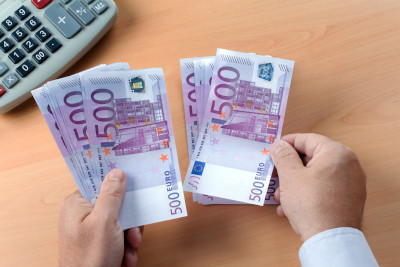
While the EU itself does not negotiate bilateral double tax treaties, member states do. Double Tax Treaties (DTA) do not deal directly with free trade but are useful in determining bilateral preferential tax treatments between countries. This is especially pertinent in the services industries. Professionally utilized DTA can reduce profits tax burdens on bilateral contracts by typically 10% when conducting trade overseas.
EU members possessing DTA with RCEP nations
Austria: Australia, China, Japan, Malaysia, New Zealand, Philippines, Singapore, South Korea, Thailand & Vietnam.
Belgium: Australia, China, Indonesia, Japan, Malaysia, New Zealand, Philippines, Singapore, South Korea, Thailand & Vietnam.
Bulgaria: China, Japan, Singapore, South Korea, Thailand & Vietnam.
Croatia: China, Indonesia, Japan, Malaysia, South Korea & Vietnam.
Cyprus: China & Singapore,
Czech Republic: Australia, China, Japan, Malaysia, New Zealand, Philippines, Singapore, South Korea, Thailand & Vietnam.
Denmark: Australia, China, Japan, Malaysia, New Zealand, Philippines, Singapore, South Korea, Thailand & Vietnam.
Estonia: China, Japan, Sinngapore, South Korea, Thailand & Vietnam.
Finland: Australia, China, Indonesia, Japan, Malaysia, New Zealand, Philippines, Singapore, South Korea, Thailand & Vietnam.
France: Australia, China, Indonesia, Japan, Malaysia, New Zealand, Philippines, Singapore, South Korea & Vietnam.
Germany: Australia, China, Japan, Malaysia, New Zealand, Philippines, Singapore, South Korea, Thailand & Vietnam.
Greece: Australia, China, Singapore & South Korea,
Hungary: Australia, China, Japan, Malaysia, Philippines, Singapore, South Korea, Thailand & Vietnam.
Ireland: Australia, China, Japan, New Zealand, Singapore, South Korea & Vietnam.
Italy: Australia, China, Indonesia, Japan, New Zealand, Philippines, Singapore, South Korea, Thailand & Vietnam.
Latvia: China, Japan, Singapore, South Korea & Vietnam.
Lithuania: China, Japan, Singapore & South Korea,
Luxembourg: Brunei, China, Indonesia, Japan, Laos, Malaysia, Singapore, South Korea, Thailand & Vietnam.
Malta: Australia, China, Malaysia, Singapore, South Korea & Vietnam.
Netherlands: Australia, China, Indonesia, Japan, Malaysia, Philippines, Singapore, South Korea, Thailand & Vietnam.
Poland: Australia, China, Indonesia, Japan, Malaysia, New Zealand, Philippines, Singapore, South Korea, Thailand & Vietnam.
Portugal: China, Japan, Singapore, South Korea & Vietnam.
Romania: Australia, China, Japan, Malaysia, Philippines, Singapore, South Korea, Thailand & Vietnam.
Slovakia: Australia, China, Indonesia, Malaysia, Singapore, South Korea & Vietnam.
Slovenia: China, Japan, Singapore, South Korea & Thailand,
Spain: Australia, China, Japan, Malaysia, New Zealand, Philippines, Singapore, South Korea, Thailand & Vietnam.
Sweden: Australia, China, Japan, Malaysia, New Zealand, Philippines, Singapore, South Korea, Thailand & Vietnam.
Please contact us at asia@dezshira.com for advisory services related to EU member tax treaties with any of these countries.
Understanding the strategic use of the various EU existing free trade, and double tax agreements with RCEP members requires professional advice. The EU FTA with Japan, Singapore, South Korea, and Vietnam should be studied, in conjunction with the applicable national DTA and analyzed to note where RCEP compatibility occurs. Dezan Shira & Associates has conducted extensive research into this issue and has professionals on the ground in our 28 offices throughout the Asian region in addition to liaison offices in Italy and Germany. For assistance with developing an EU-RCEP market access strategy, please contact us at asia@dezshira.com or visit us at www.dezshira.com
Related Reading
About Us
China Briefing is written and produced by Dezan Shira & Associates. The practice assists foreign investors into China and has done so since 1992 through offices in Beijing, Tianjin, Dalian, Qingdao, Shanghai, Hangzhou, Ningbo, Suzhou, Guangzhou, Dongguan, Zhongshan, Shenzhen, and Hong Kong. Please contact the firm for assistance in China at china@dezshira.com.
Dezan Shira & Associates has offices in Vietnam, Indonesia, Singapore, United States, Germany, Italy, India, and Russia, in addition to our trade research facilities along the Belt & Road Initiative. We also have partner firms assisting foreign investors in The Philippines, Malaysia, Thailand, Bangladesh.
- Previous Article How British Business Can Access China’s New £18 Trillion Asia RCEP Free Trade Agreement via the Back Door
- Next Article Shenzhen’s New Data Regulations Explained









